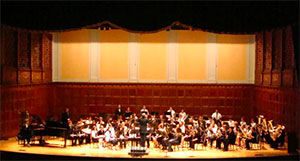by Robert Rollin

The stunning highlight was Ottorino Respighi’s impressionistic symphonic tone poem, The Pines of Rome. After traveling to St. Petersburg to study with Rimsky-Korsakov, one of the greatest orchestrators of the day, Respighi composed his three famous tone poems, The Fountains of Rome (1917), The Pines of Rome (1924), and Roman Festivals (1928).
The Pines, in four continuous movements, is a masterpiece of orchestral color. The first movement, “The Pines of the Villa Borghese,” portrays children playing among the trees on an early sunny morning in the Villa Borghese gardens. Italian nursery rhymes and children’s soldier games are included. The timbral vividness of the performance was a delight.
“The Pines Near a Catacomb” uses dark, low brasses, a 32-foot organ stop, and an offstage trumpet playing a Gregorian hymn to conjure up the silhouette of an isolated chapel near a few lone pines. The dirge-like mood evokes images of skulls piled up in a catacomb. The low brasses were especially effective, playing submerged Gregorian hymn melodies in the middle of a complex texture.
“The Pines of the Janiculum” depicts the hilltop temple of Janus under moonlight in an evocative movement employing intriguing percussion sounds and the first historical use of recorded nightingale song to support its other colors. The effect was particularly intriguing in Powers Auditorium’s resonant acoustics.
“The Pines of the Appian Way,” paints pine trees in a misty dawn and a triumphant Roman legion advancing along the road to Rome in the brilliant rising sun. Again, low organ tones are used to create tension, giving the effect of the ground trembling as the long column of soldiers passes.
Fleischer controlled the proceedings beautifully, but when he cued the six balcony-situated flugelhorns, they proved to be inaudible in the overwhelmingly complex texture. The timpani- and percussion-supported closing crescendo was exceptional.
Particularly beautiful solos by principal cellist Michael Gelfand, accompanied by his section and answered by concertmaster Joseph Kromholz, adorned the performance.
Respighi composed three suites of Ancient Airs and Dances. The Orchestra performed the first, based on lute pieces by several Renaissance composers. The sensitively-scored polyphonic lines showed a completely different side of this talented composer.
In the second half of the program, the YSO’s performance of Antonio Vivaldi’s Concerto in a for Two Violins and Strings was sensitive and gorgeous. Of the three movements, the final Allegro most attractively displayed the skills of the soloists, Joseph Krumholz and principal second violinist Susan Brenneis Fisher. The exact coloristic matches of their echoing entrances were exquisite.
The evening opened with a rare concert performance of Claudio Monteverdi’s short fanfare-like Orfeo Overture (1607). Fleischer placed the two solo trumpeters at opposite sides on the stage to create vibrant antiphonal effects and a sparkling performance.
Rossini’s five-part William Tell Overture was great fun as always. In addition to the fast section of Lone Ranger fame, the Dawn portion simmered with sensitivity and expression. Verdi’s Triumphal March from Aida, presented here without soloists or chorus, effectively balanced the powerful brasses with other sections.
Mozart wrote his opera Idomeneo, K. 366 for Karl-Theodore, the Elector of Bavaria. Mindful of the success of his colleague Gluck, the composer included a set piece for ballet in the French manner. The performance of this early Mozart piece moved solemnly to an effective close.
Even darker was the “Sunrise Prelude” from Puccini’s Madama Butterfly. It takes place just before Cio Cio San commits suicide, having resigned herself to the adoption of her illegitimate son by her former lover Pinkerton and his new American wife. The tasteful performance was quite moving.
Published on ClevelandClassical.com November 8, 2016.
Click here for a printable copy of this article



